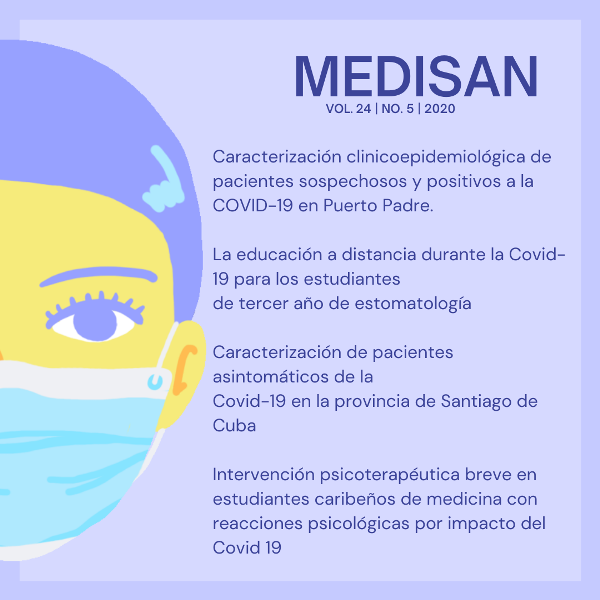Imaging patterns in patients under 5 years with diagnosis of bacterial pneumonia
Keywords:
children, bacterial pneumonia, imaging patterns, secondary health care.Abstract
Introduction: Chest radiography is the best diagnostic method for clinical confirmation of pneumonia, although there are discrepancies in its relation to causation.
Objective: To describe imaging patterns according to clinical, epidemiological, and microbiological variables, in patients under five years of age admitted for bacterial pneumonia.
Methods: descriptive, prospective, and cross-sectional study of 84 patients diagnosed with pneumonia and bacterial isolation in blood cultures and / or pleural fluid. Variables of interest were operationalized, with frequency, and percentage calculations being performed.
Results: alveolar consolidation (57.1 %) prevailed in preschoolers, male sex, with previous antimicrobial treatment, early suppression of breastfeeding, and smoking at home. Fever, cough, tachypnea, retraction, rhinorrhea, and wet rales were the most frequent symptoms. Pneumococcus prevailed (64.6 %) in patients with alveolar condensation pattern.
Conclusions: the pattern of alveolar consolidation was consistent with pneumococcal causality predominantly; with multiple risk factors and typical clinical presentation of bacterial pneumonia.
Downloads
References
2. Organización Mundial de la Salud. Neumonía, 2016 [citado 23/03/2019]. Disponible en: http://www.who.int/es/news-room/fact-sheets/detail/pneumonia
3. Cuba. Ministerio de Salud Pública. Programa Integral de Prevención y Control de las Infecciones Respiratorias Agudas. La Habana: MINSAP; 2013.
4. le Roux DM, Zar H. Community-acquired pneumonia in children — a changing spectrum of disease. Pediatr Radiol. 2017 [citado 23/03/2019];47(11):1392-8. Disponible en: https://pubmed.ncbi.nlm.nih.gov/29043417/
5. Grupo de Trabajo para la Vigilancia y Evaluación de Impacto. Proyecto Neumococo. Vigilancia y evaluación del impacto de la vacuna cubana contra los neumococos. Protocolo de vigilancia centinela integrada de base hospitalaria. La Habana, 2014 [citado 16/09/2017]. Disponible en: http://www.portalesmedicos.com.finlay.edu.cu
6. Tamayo Reus CM, Bastart Ortiz CE. Morbilidad por infecciones respiratorias agudas en pacientes menores de 5 años. MEDISAN. 2013 [citado 17/11/2019]; 17(12). Disponible en: http://scielo.sld.cu/scielo.php?script=sci_arttext&pid=S1029-30192013001200007
7. Tamayo Reus CM, Díaz Terán D, Leyva Peguero YE. Aspectos clínicos y radiográficos de la neumonía típica condensante en menores de 5 años. MEDISAN. 2014 [citado 23/03/2019];18(4). Disponible en: http://scielo.sld.cu/scielo.php?script=sci_arttext&pid=S1029-30192014000400009
8. Kliegman R, Stanton B, Geme J. Nelson. Textbook of pediatrics. 20ed. Philadelphia: Elsevier;2016.
9. Tamayo Reus CM. Catarro común y violencia terapéutica en los niños. Santiago de Cuba: Editorial Oriente; 2015.
10. Wilmott R, BushA, Deterding R, Ratjen F, Sly P, Zar H, et al. Enfermedades respiratorias en niños. 9ed. Madrid: Elsevier.p. 427-9.
11. Gentile A, Bardach A, Ciapponi A, GarcíaMarti S, Aruj P, Glujovsky D, et al. Epidemiology of community-acquired pneumonia in children of Latin America and the Caribbean: a systematic reand meta-analysis. Int J Infect Dis. 2012 [citado 23/01/2019]; 16(1). Disponible en: https://pubmed.ncbi.nlm.nih.gov/22056731/
12. Molina Águila N, DotresC, LegarretaE, Vega D, Piedra M. Comportamiento de la enfermedad neumocócica en el Hospital Pediátrico "Juan Manuel Márquez". Rev Cubana Pediatr. 2017 [citado 23/01/2019];89(sup). Disponible en: http://www.revpediatria.sld.cu/index.php/ped/article/view/86/96
13. Rodríguez Cutting JM, Calero Galeas AE, Vega Mendoza D, Pacheco Torres L. Neumonía complicada adquirida en la comunidad: resolución de los hallazgos clínicos y radiológicos en niños. Rev Haban Ciencias Médicas. 2015 [citado 20/05/2019];14(4). Disponible en: http://scielo.sld.cu/scielo.php?script=sci_arttext&pid=S1729-519X2015000400007
14. Álvarez Andrade ME, Hernández M, Brito Y, Sánchez L, Cuevas D. Riesgo de neumonía grave en niños menores de 5 años. Rev Haban Cienc Méd. 2018 [citado 20/05/2019];17(3). Disponible en: http://scielo.sld.cu/scielo.php?script=sci_arttext&pid=S1729-519X2018000300408&lng=es&nrm=iso&tlng=es
15. Murray P, Rosenthal K, Pfaller M. Microbiología médica. 8 ed. Madrid: Elsevier; 2017.
16. Vargas Neyra JA. Características clínico-epidemiológicas de la neumonía adquirida en la comunidad en menores de 5 años. Rev UCV- Scientia Biomédica. 2018 [citado 20/05/2019];1(2).Disponible en:http://revistas.ucv.edu.pe/index.php/UCVSCIENTIABIOMEDICA/article/view/1823
17. Organización Panamericana de la Salud. Datos por país y por grupos de edades sobre las características de los aislamientos de Streptococcus pneumoniae, Haemophilus influenzaey Neisseria meningitidis en procesos invasores. Washington, DC: OPS; 2015.
18. Abreu Suárez G, Fuentes G, Domínguez IM, Portuondo R, Pérez M, Toraño G. Enfermedad neumocócica invasiva en niños con neumonía grave adquirida en la comunidad. Rev Cubana Pediatr. 2017 [citado 20/05/2019]; 89(sup). Disponible en: http://www.revpediatria.sld.cu/index.php/ped/article/view/118/95
19. Elemraid M, Muller M, Spencer D, Rushton S, Gorton R, Thomas M. Accuracy of the interpretation of chest radiographs for the diagnosis of paediatric pneumonia. PLoS One. 2014; 9(8):e106051.
Published
How to Cite
Issue
Section
License
All the articles can be downloaded or read for free. The journal does not charge any amount of money to the authors for the reception, edition or the publication of the articles, making the whole process completely free. Medisan has no embargo period and it is published under the license of Creative Commons, International Non Commercial Recognition 4.0, which authorizes the copy, reproduction and the total or partial distribution of the articles in any format or platform, with the conditions of citing the source of information and not to be used for profitable purposes.





